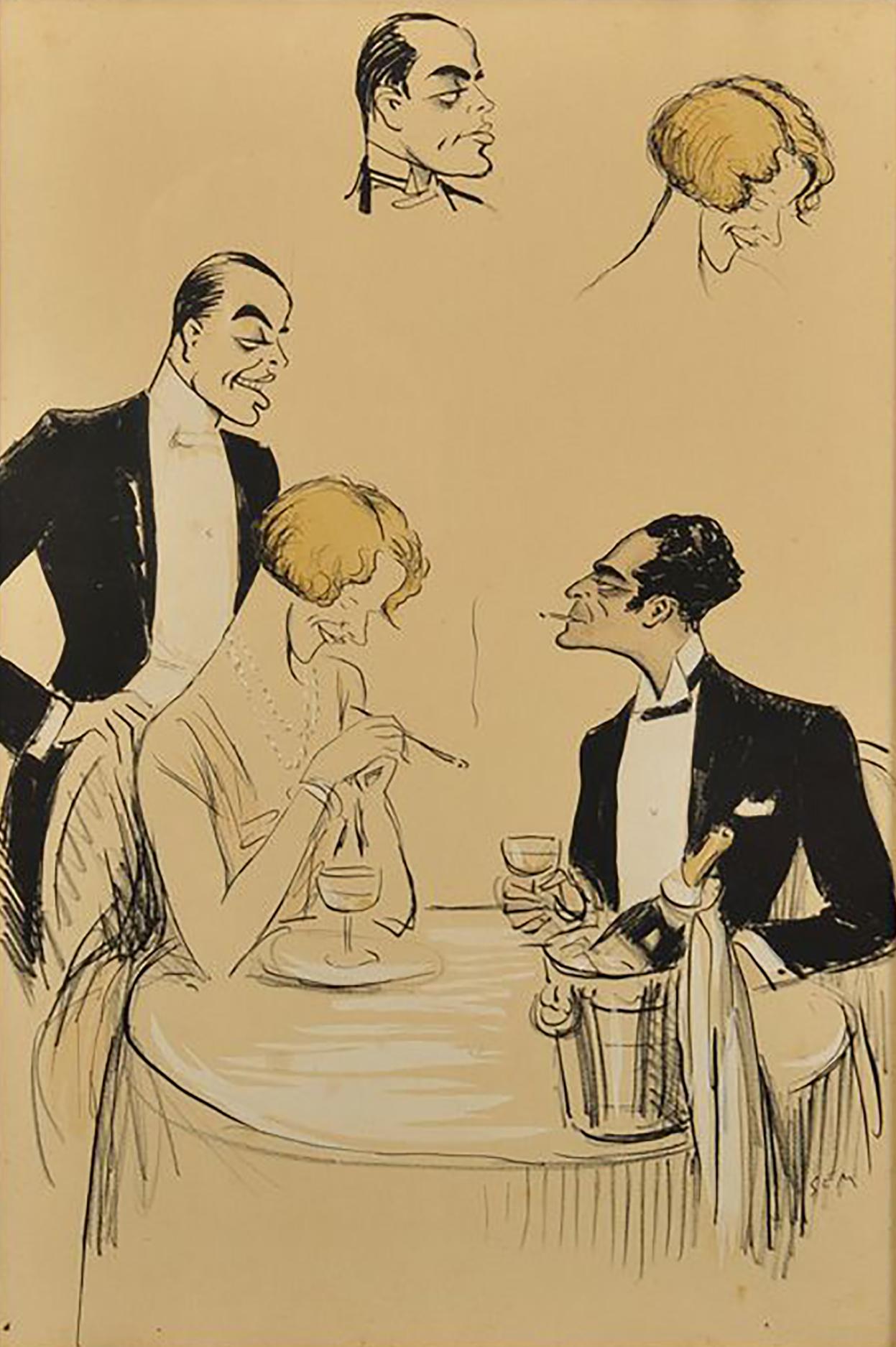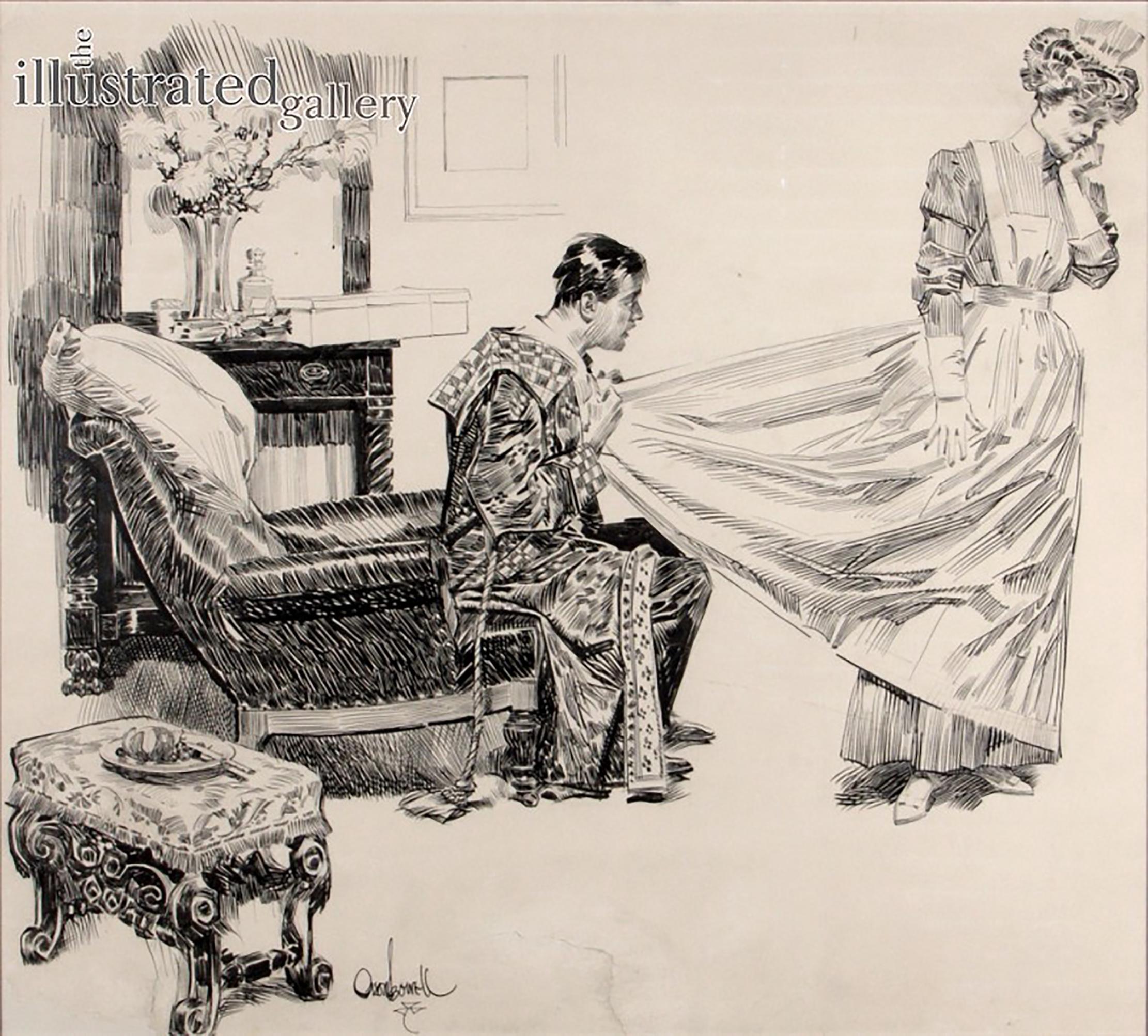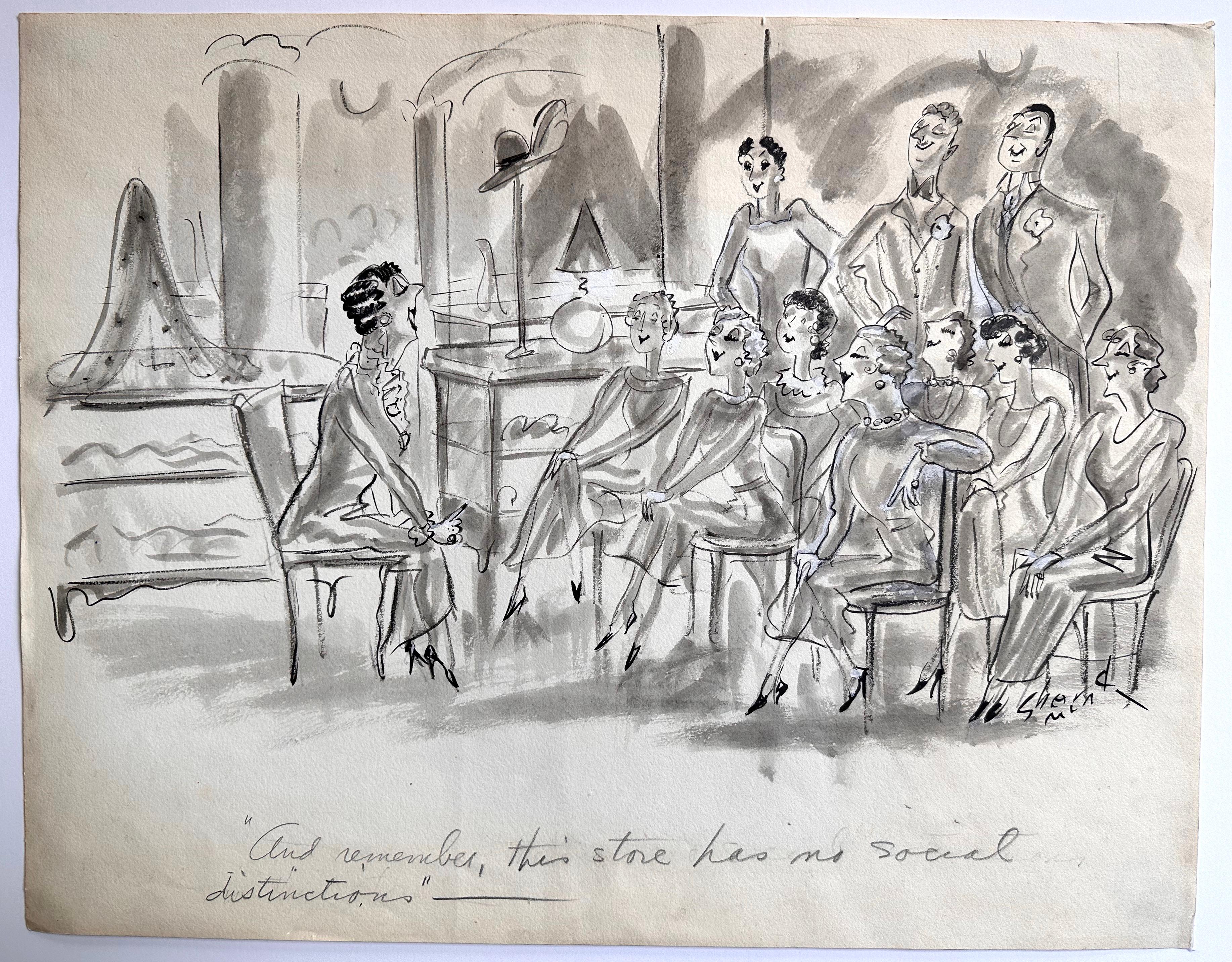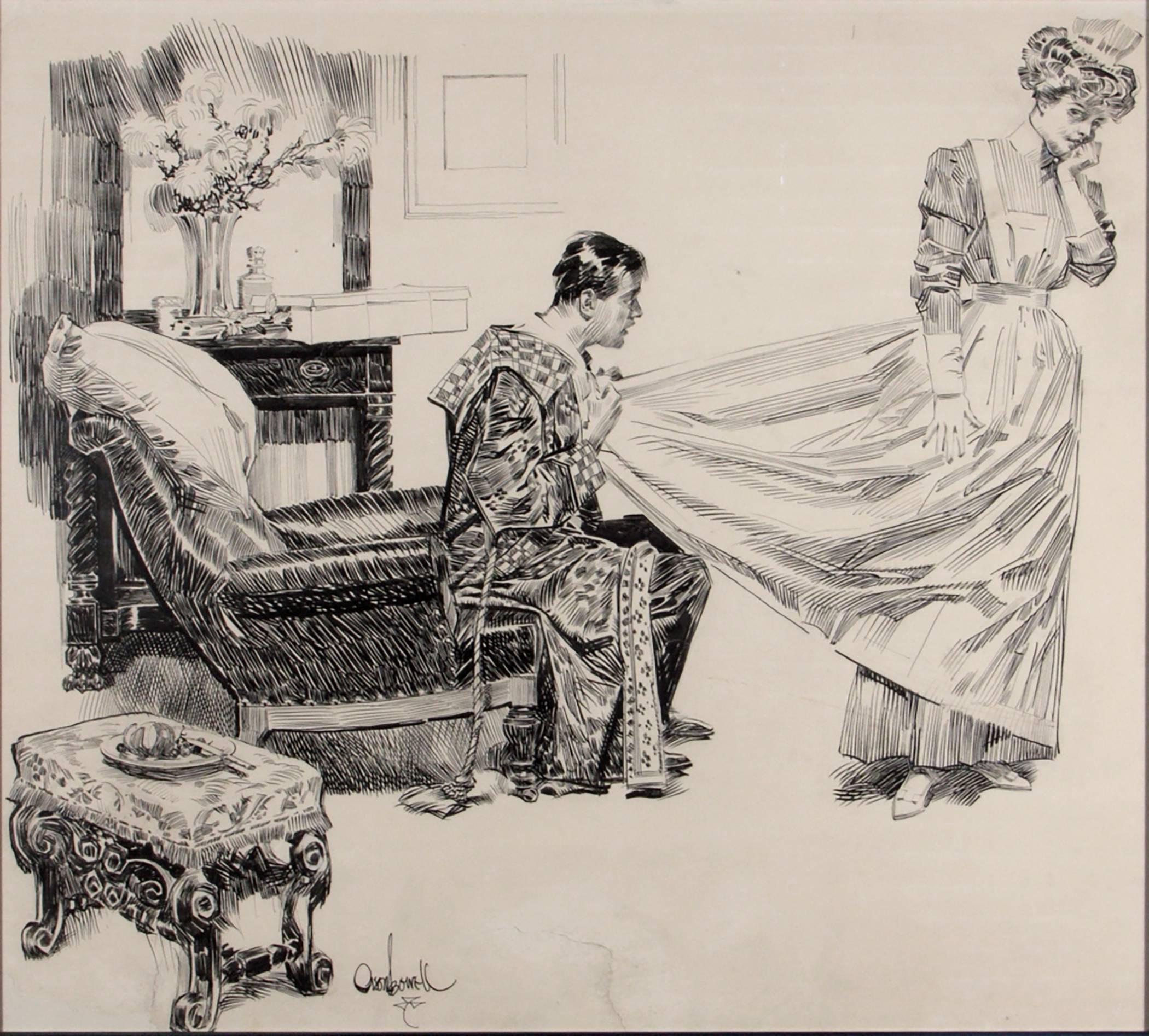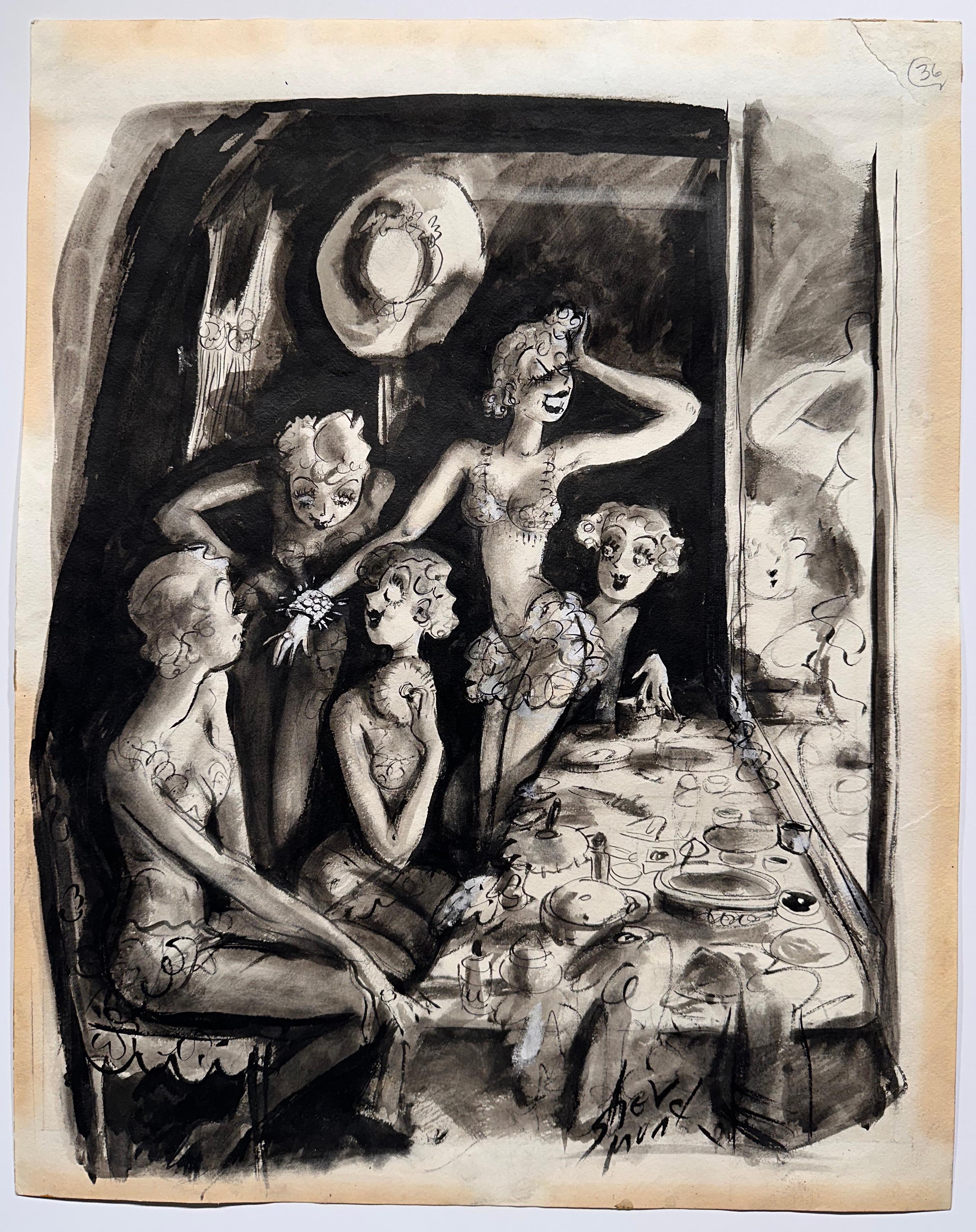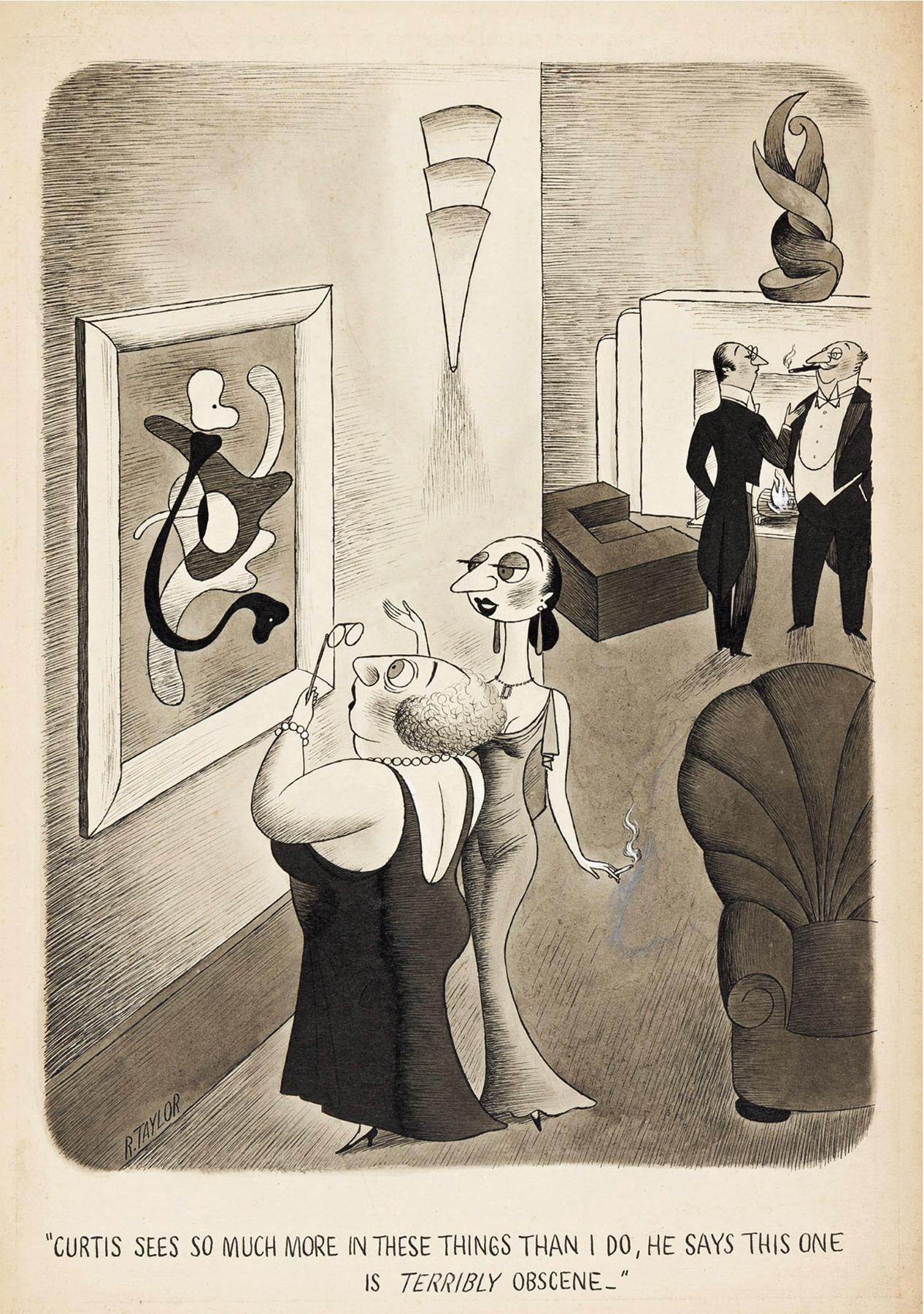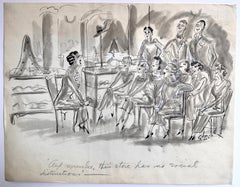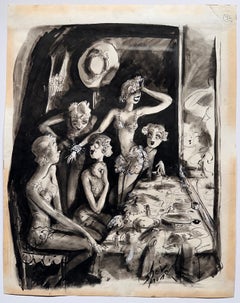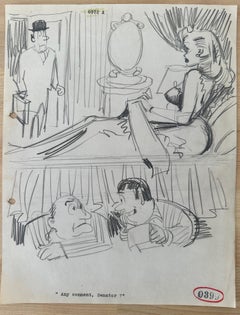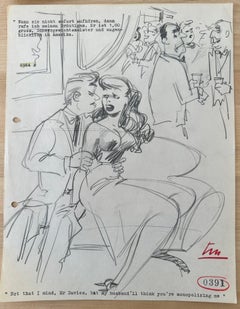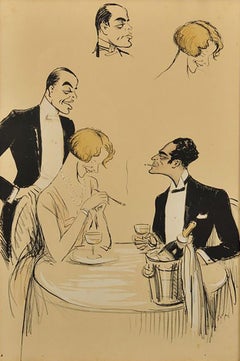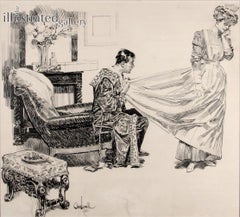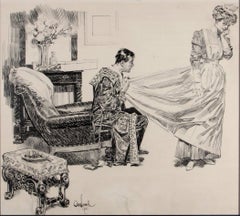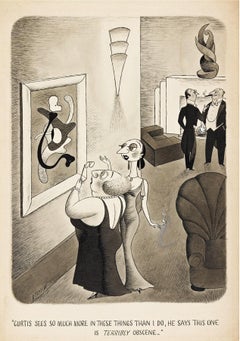Items Similar to Life Magazine Satirical Society Cartoon Illustration
Want more images or videos?
Request additional images or videos from the seller
1 of 13
BARBARA SHERMUNDLife Magazine Satirical Society Cartoon Illustration1940s
1940s
$2,500
£1,881.02
€2,172.62
CA$3,533.15
A$3,834.01
CHF 2,031.69
MX$47,022.26
NOK 25,141.98
SEK 23,757.84
DKK 16,219.66
About the Item
Barbara Shermund (1899-1978). Society Satirical Cartoon, ca. 1940s. Gouache on heavy illustration paper, image measures 17 x 14 inches; 23 x 20 inches in matting. Signed lower left. Very good condition but matting panel should be replaced. Unframed.
Provenance: Ethel Maud Mott Herman, artist (1883-1984), West Orange NJ.
For two decades, she drew almost 600 cartoons for The New Yorker with female characters that commented on life with wit, intelligence and irony.
In the mid-1920s, Harold Ross, the founder of a new magazine called The New Yorker, was looking for cartoonists who could create sardonic, highbrow illustrations accompanied by witty captions that would function as social critiques.
He found that talent in Barbara Shermund.
For about two decades, until the 1940s, Shermund helped Ross and his first art editor, Rea Irvin, realize their vision by contributing almost 600 cartoons and sassy captions with a fresh, feminist voice.
Her cartoons commented on life with wit, intelligence and irony, using female characters who critiqued the patriarchy and celebrated speakeasies, cafes, spunky women and leisure. They spoke directly to flapper women of the era who defied convention with a new sense of political, social and economic independence.
“Shermund’s women spoke their minds about sex, marriage and society; smoked cigarettes and drank; and poked fun at everything in an era when it was not common to see young women doing so,” Caitlin A. McGurk wrote in 2020 for the Art Students League.
In one Shermund cartoon, published in The New Yorker in 1928, two forlorn women sit and chat on couches. “Yeah,” one says, “I guess the best thing to do is to just get married and forget about love.”
“While for many, the idea of a New Yorker cartoon conjures a highbrow, dry non sequitur — often more alienating than familiar — Shermund’s cartoons are the antithesis,” wrote McGurk, who is an associate curator and assistant professor at Ohio State University’s Billy Ireland Cartoon Library & Museum. “They are about human nature, relationships, youth and age.” (McGurk is writing a book about Shermund.
And yet by the 1940s and ’50s, as America’s postwar focus shifted to domestic life, Shermund’s feminist voice and cool critique of society fell out of vogue. Her last cartoon appeared in The New Yorker in 1944, and much of her life and career after that remains unclear. No major newspaper wrote about her death in 1978 — The New York Times was on strike then, along with The Daily News and The New York Post — and her ashes sat in a New Jersey funeral home for nearly 35 years until they were claimed by a descendant in search of information about her.
Barbara Shermund was born on June 26, 1899, in San Francisco. Her father, Henry Shermund, was an architect; her mother, Fredda Cool, a sculptor. Barbara displayed a knack for illustrating at a young age, and her parents encouraged her to explore her passion. She published her first cartoon when she was 8, in the children’s section of The San Francisco Chronicle.
Shermund’s mother died in 1918 in the Spanish flu pandemic. Some years later, her father married a woman 31 years his junior and eight years younger than Barbara. As her father and his new wife went on to build their own family, Barbara became estranged from them.
She attended the California School of Fine Arts (now the San Francisco Art Institute) to study printmaking and painting and regularly won awards.
She moved to New York City in her mid-20s to seek an independent life while pursuing her artistic ambitions, finding work creating cover art, cartoons and illustrations for magazines like Esquire, Life and Collier’s.
She is believed to have met Harold Ross and Rea Irvin through mutual connections from her studies and in the magazine industry. Her contributions to The New Yorker included about nine cover illustrations as well as spot illustrations and section mastheads that helped set the magazine’s visual tone.
Her perspective was influenced by her intersection with profound historical moments: In addition to surviving the Spanish flu pandemic, Shermund lived through World War I and the suffrage movement.
One of her cartoons from the 1920s, after women won the right to vote, depicted two men in tuxedos smoking by a grand fireplace, with one saying in the caption, “Well, I guess women are just human beings, after all.”
In 1943, Esquire magazine sent Shermund to the Hollywood set of the musical comedy “Du Barry Was a Lady” to sketch actresses performing in an I Love an Esquire Girl sequence. She created as well a promotional poster for the film, starring Red Skelton and Lucille Ball.
She also took on advertising commissions at a time when women were rare in that industry, illustrating ads for companies like Pepsi-Cola, Ponds, Philips 66 and Frigidaire.
From 1944 until about 1957, she produced Shermund’s Sallies, a syndicated cartoon panel for Pictorial Review, the arts and entertainment section of Hearst’s many Sunday newspaper.
Shermund lived out her last years drawing at her home in Sea Bright, N.J., and swimming at a beach nearby. She died on Sept. 9, 1978, at a nursing home in Middletown, N.J.
“The women she drew and the captions she wrote showed us women who were not afraid of making fun of men, and showed us what it was really like to be a woman,” Liza Donnelly, a cartoonist and writer at The New Yorker, said in an interview. “Shermund’s women had humor and guts, just like what I imagine the artist had herself.”
Perhaps one of Shermund’s most striking pieces is indicative of her irreverent and fearless spirit in life: A young girl sits on the lap of a paternal figure and says, “Please, tell me a story where the bad girl wins!”
About the Seller
4.9
Platinum Seller
Premium sellers with a 4.7+ rating and 24-hour response times
Established in 2007
1stDibs seller since 2015
417 sales on 1stDibs
Typical response time: 2 hours
- ShippingRetrieving quote...Shipping from: Wilton Manors, FL
- Return Policy
Authenticity Guarantee
In the unlikely event there’s an issue with an item’s authenticity, contact us within 1 year for a full refund. DetailsMoney-Back Guarantee
If your item is not as described, is damaged in transit, or does not arrive, contact us within 7 days for a full refund. Details24-Hour Cancellation
You have a 24-hour grace period in which to reconsider your purchase, with no questions asked.Vetted Professional Sellers
Our world-class sellers must adhere to strict standards for service and quality, maintaining the integrity of our listings.Price-Match Guarantee
If you find that a seller listed the same item for a lower price elsewhere, we’ll match it.Trusted Global Delivery
Our best-in-class carrier network provides specialized shipping options worldwide, including custom delivery.More From This Seller
View AllFancy Department Store Satirical Cartoon
Located in Wilton Manors, FL
Barbara Shermund (1899-1978). Fancy Department Store Satirical Cartoon, ca. 1930's. Ink, watercolor and gouache on heavy illustration paper, panel measures 19 x 15 inches. Signed lower right. Very good condition. Unframed.
Provenance: Ethel Maud Mott Herman, artist (1883-1984), West Orange NJ.
For two decades, she drew almost 600 cartoons for The New Yorker with female characters that commented on life with wit, intelligence and irony.
In the mid-1920s, Harold Ross, the founder of a new magazine called The New Yorker, was looking for cartoonists who could create sardonic, highbrow illustrations accompanied by witty captions that would function as social critiques.
He found that talent in Barbara Shermund.
For about two decades, until the 1940s, Shermund helped Ross and his first art editor, Rea Irvin, realize their vision by contributing almost 600 cartoons and sassy captions with a fresh, feminist voice.
Her cartoons commented on life with wit, intelligence and irony, using female characters who critiqued the patriarchy and celebrated speakeasies, cafes, spunky women and leisure. They spoke directly to flapper women of the era who defied convention with a new sense of political, social and economic independence.
“Shermund’s women spoke their minds about sex, marriage and society; smoked cigarettes and drank; and poked fun at everything in an era when it was not common to see young women doing so,” Caitlin A. McGurk wrote in 2020 for the Art Students League.
In one Shermund cartoon, published in The New Yorker in 1928, two forlorn women sit and chat on couches. “Yeah,” one says, “I guess the best thing to do is to just get married and forget about love.”
“While for many, the idea of a New Yorker cartoon conjures a highbrow, dry non sequitur — often more alienating than familiar — Shermund’s cartoons are the antithesis,” wrote McGurk, who is an associate curator and assistant professor at Ohio State University’s Billy Ireland Cartoon Library & Museum. “They are about human nature, relationships, youth and age.” (McGurk is writing a book about Shermund.
And yet by the 1940s and ’50s, as America’s postwar focus shifted to domestic life, Shermund’s feminist voice and cool critique of society fell out of vogue. Her last cartoon appeared in The New Yorker in 1944, and much of her life and career after that remains unclear. No major newspaper wrote about her death in 1978 — The New York Times was on strike then, along with The Daily News and The New York Post — and her ashes sat in a New Jersey funeral home...
Category
1930s Realist Figurative Paintings
Materials
Gouache, Ink
$1,875 Sale Price
25% Off
Life Magazine Art Deco Showgirls Cartoon
Located in Wilton Manors, FL
Barbara Shermund (1899-1978). Showgirls Cartoon for Life Magazine, 1934. Ink, watercolor and gouache on heavy illustration paper, matting window measures 16.5 x 13 inches; sheet measures 19 x 15 inches; Matting panel measures 20 x 23 inches. Signed lower right. Very good condition with discoloration and toning in margins. Unframed.
Provenance: Ethel Maud Mott Herman, artist (1883-1984), West Orange NJ.
For two decades, she drew almost 600 cartoons for The New Yorker with female characters that commented on life with wit, intelligence and irony.
In the mid-1920s, Harold Ross, the founder of a new magazine called The New Yorker, was looking for cartoonists who could create sardonic, highbrow illustrations accompanied by witty captions that would function as social critiques.
He found that talent in Barbara Shermund.
For about two decades, until the 1940s, Shermund helped Ross and his first art editor, Rea Irvin, realize their vision by contributing almost 600 cartoons and sassy captions with a fresh, feminist voice.
Her cartoons commented on life with wit, intelligence and irony, using female characters who critiqued the patriarchy and celebrated speakeasies, cafes, spunky women and leisure. They spoke directly to flapper women of the era who defied convention with a new sense of political, social and economic independence.
“Shermund’s women spoke their minds about sex, marriage and society; smoked cigarettes and drank; and poked fun at everything in an era when it was not common to see young women doing so,” Caitlin A. McGurk wrote in 2020 for the Art Students League.
In one Shermund cartoon, published in The New Yorker in 1928, two forlorn women sit and chat on couches. “Yeah,” one says, “I guess the best thing to do is to just get married and forget about love.”
“While for many, the idea of a New Yorker cartoon conjures a highbrow, dry non sequitur — often more alienating than familiar — Shermund’s cartoons are the antithesis,” wrote McGurk, who is an associate curator and assistant professor at Ohio State University’s Billy Ireland Cartoon Library & Museum. “They are about human nature, relationships, youth and age.” (McGurk is writing a book about Shermund.
And yet by the 1940s and ’50s, as America’s postwar focus shifted to domestic life, Shermund’s feminist voice and cool critique of society fell out of vogue. Her last cartoon appeared in The New Yorker in 1944, and much of her life and career after that remains unclear. No major newspaper wrote about her death in 1978 — The New York Times was on strike then, along with The Daily News and The New York Post — and her ashes sat in a New Jersey funeral home...
Category
1930s Art Deco Figurative Paintings
Materials
Ink, Gouache
$3,250 Sale Price
35% Off
Humorous Gentleman's Magazine cartoon
Located in Wilton Manors, FL
Cartoon sketch, ca. 1955. Pencil on paper, sheet measures 8.5 x 11 inches. Unsigned with editor's notations.
From a group of sketches meant to be preliminary drafts for editor appro...
Category
Mid-20th Century Figurative Drawings and Watercolors
Materials
Pencil
$125 Sale Price
50% Off
Humorous Gentleman's Magazine cartoon
Located in Wilton Manors, FL
Cartoon sketch, ca. 1955. Pencil on paper, sheet measures 8.5 x 11 inches. Unsigned with editor's notations.
From a group of sketches meant to be preliminary drafts for editor appro...
Category
Mid-20th Century Figurative Drawings and Watercolors
Materials
Pencil
$125 Sale Price
50% Off
Humorous Gentleman's Magazine cartoon
Located in Wilton Manors, FL
Cartoon sketch, ca. 1955. Pencil on paper, sheet measures 8.5 x 11 inches. Unsigned with editor's notations.
From a group of sketches meant to be preliminary drafts for editor appro...
Category
Mid-20th Century Figurative Drawings and Watercolors
Materials
Pencil
$125 Sale Price
50% Off
Humorous Gentleman's Magazine cartoon
Located in Wilton Manors, FL
Cartoon sketch, ca. 1955. Pencil on paper, sheet measures 8.5 x 11 inches. Unsigned with editor's notations.
From a group of sketches meant to be preliminary drafts for editor appro...
Category
Mid-20th Century Figurative Drawings and Watercolors
Materials
Pencil
$125 Sale Price
50% Off
You May Also Like
Political Cartoon
By George Goursat
Located in Fort Washington, PA
Medium: Pen and Ink on Board
Signature: Signed Lower Right
A political cartoon of a man and a woman at a dinner table.
Category
Late 19th Century Figurative Drawings and Watercolors
Materials
Ink, Board, Pen
Life Magazine Story Illustration
By Orson Byron Lowell
Located in Fort Washington, PA
Medium: Pen and Ink on Board
Signature: Signed Lower Left
Story Illustration- Life Magazine ca. 1915
Seated Man in dressing gown pulling on maid's apron
Category
1910s Figurative Drawings and Watercolors
Materials
Ink, Board, Pen
Life Magazine Story Illustration
By Orson Lowell
Located in Fort Washington, PA
Approximate Date: 1915
Medium: Pen and Ink on Board
Signature: Signed Lower Left
Dimensions: 22.00" x 20.00"
Story Illustration- Life Magazine ca. ...
Category
1910s Figurative Paintings
Materials
Ink, Board, Pen
Art Lovers and Art Critics Analyzing Obscene Painting. Cartoon
By Richard Taylor
Located in Miami, FL
Cartoonist Richard Taylor was trained in academic art. He frequently comments on abstract art which was the new and radical thing at the time. "Curtis sees so much more in these thi...
Category
1940s Academic Portrait Drawings and Watercolors
Materials
Ink, Board
Woman's Day Illustration
By George Hughes
Located in Fort Washington, PA
Framed, Under glass
Category
Mid-20th Century Figurative Drawings and Watercolors
Materials
Pencil
What is the Home Anyway
By Orson Byron Lowell
Located in Fort Washington, PA
Medium: Pen and Ink on Paper
Signature: Unsigned
Titled in pencil and inscribed "Blue print-Rush-/March" beneath the composition, identified in a printed label affixed to the frame ...
Category
1910s Figurative Drawings and Watercolors
Materials
Ink, Pen
